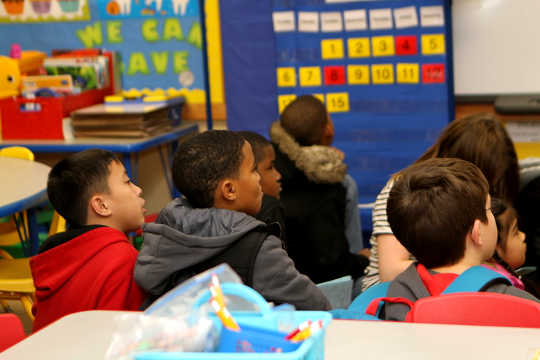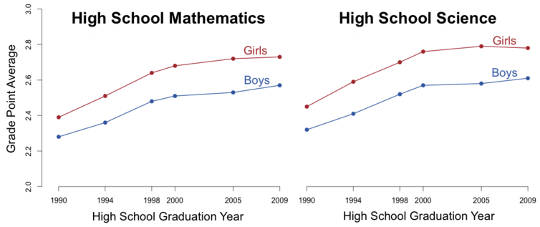
Even young students hold beliefs about which gender is better at what. U.S. Army Garrison Red Cloud, CC BY-NC-ND
By age six, girls are less likely than boys to view their own gender as brilliant and express interest in activities described as for “really, really smart” children, according to new research published in Science.
Many major media outlets reported these findings. Most of the coverage, however, overlooked another key finding from the same study: Boys were less likely to say their own gender gets top grades in school.
The beliefs of children matter because they could shape students’ interests and achievement over time, other research suggests. For instance, one 2013 experiment found that telling elementary school children “girls do better than boys” in school made boys – but not girls – perform worse on a series of academic tests. These expectations can work both ways: When researchers told children that boys and girls would perform the same, boys’ academic performance improved.
There are real and persistent gender achievement gaps in the U.S. For instance, boys tend to get worse grades than girls, but girls are few among top scorers on standardized math tests. While much research has studied how stereotypes about achievement can make girls underperform, the gaps where boys do worse have often been historically overlooked. But stereotypes can harm boys too – just in different ways.
Who gets the grades, who’s super smart?
In the new Science study on children’s views about brilliance, developmental psychologists asked 144 children aged five to seven years a series of questions about school achievement. For instance, children had to guess which of two unfamiliar boys and two unfamiliar girls “gets the best grades in school.”
Children tended to favor their own gender, but boys did so to a lesser extent. Among seven-year-olds, 79 percent of girls selected girls as the better student, but 55 percent of boys selected boys.
These results sharply contrasted with those about brilliance. When asked to guess who was “really, really smart,” girls instead expressed less confidence in their gender. Among seven-year-olds, 55 percent of girls selected girls as being super smart, but 66 percent of boys selected boys.
In other words, these young children overall held positive beliefs about their gender. But boys were less certain about their gender getting good grades and girls were less certain about their gender being super smart.
Other research has found that, by fifth grade, both boys and girls say that girls work harder at school, want to learn more, listen better, follow instructions better, are more polite and – perhaps as a result – perform better in school.
Reality of gender achievement gaps
Children’s stereotypes reflect reality to an extent. For instance, girls have gotten better school grades in all subject areas for nearly a century, according to a recent synthesis of 308 studies that included over one million students. This female advantage started in elementary school and continued until college.
Girls get better grades, even in math and science – two subject areas often assumed to favor boys. Women also now earn more bachelor’s degrees, master’s degree and – since 2007 – doctoral degrees than men in the U.S.

Girls get better grades even in math and science. U.S. Department of Education, Institute of Education Sciences, National Center for Education Statistics, High School Transcript Study (HSTS), various years, 1990-2009
Despite their advantage in grades and degree attainment, girls are underrepresented among the highest scorers on standardized mathematics and science tests. For instance, boys typically outnumber girls by between two and four to one among the top 1 percent or higher of math scorers. However, girls tend to slightly outnumber boys among top scorers on standardized reading and writing tests.
Children’s views about who is “really, really smart” therefore partly match the reality of who gets top scores on mathematics (but not reading or writing) standardized tests.
Self-fulfilling stereotypes
But children’s stereotypes may do more than merely reflect reality: They may help create that reality through self-fulfilling prophecies. For instance, if girls doubt their gender can be brilliant, girls might then avoid “super smart” activities like advanced math summer camps and then not develop precocious mathematics talent. In other words, stereotypes and reality could mutually strengthen each other.
Consistent with these hypotheses, the new Science study also found that, by age six, girls expressed less interest than boys in games described as for “children who are really, really smart” (though more research is needed to see if stereotypes directly caused this gap in interests).
Stereotypes could negatively affect boys too. As experiments on elementary school children suggest, beliefs about boys’ academic inferiority or poor reading ability could make boys underperform on evaluative academic tests.
Teachers’ stereotypes also matter. For instance, teachers’ beliefs that girls are better readers predict declines from grade five to grade six in boys’ – but not girls’ – confidence in their reading skills. Researchers also find that teachers often view boys as “lazy, disruptive, unfocused, and lacking motivation.” This stereotype about troublesome boys could negatively bias teachers’ perceptions of boys’ learning, one experiment found.
These results suggest stereotypes contribute to gender achievement gaps, but they certainly aren’t the only factor at work. For instance, girls’ advantage in grades might also be tied to actual differences in classroom behavior or activity level.
{youtube}OFpYj0E-yb4{/youtube}
Boys’ rowdiness in school — and teachers’ intolerance of it — might also contribute to girls’ advantage in grades, argues philosopher Christina Hoff Sommers.
Maximizing all children’s potential
Stereotypes could therefore hold back both girls and boys, but in distinct domains. Beliefs about brilliance might deter girls from top intellectual pursuits, but beliefs about grades and classroom behavior might harm boys in school more broadly across the achievement spectrum.
Both sets of findings are important. However, people often appear much less concerned with stereotypes negatively affecting boys than those affecting girls. For instance, several tweets about this new study described its results about brilliance as “sad” and “depressing,” but its results about grades went largely unnoticed.
Data on boys’ underachievement also have often been historically overlooked in media attention and educational policies. Some writers even argue that boys’ educational struggles aren’t “worrisome” because “the workplace is still stacked against [women].”
But it’s not constructive to pit one gender against the other. Recognizing contexts that favor females doesn’t erase biases against them elsewhere. More importantly, the goal of education should be to maximize all students’ potential and remove obstacles in their way. Regardless of the individual strengths students bring to school, stereotypes shouldn’t determine how far they go. Realizing that goal requires identifying and mitigating how stereotypes can also hold boys back in school.
![]()
About The Author
David Miller, Doctoral Student in Psychology, Northwestern University
This article was originally published on The Conversation. Read the original article.
Related Books
at InnerSelf Market and Amazon























